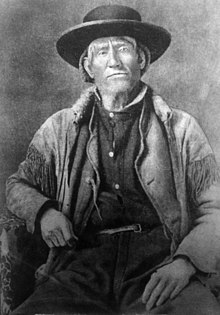Bridger Trail

The Bridger Trail, also known as the Bridger Road and Bridger Immigrant Road, was an overland route connecting the Oregon Trail to the gold fields of Montana. Gold was discovered in Virginia City, Montana in 1863, prompting settlers and prospectors to find a trail to travel from central Wyoming to Montana. In 1863, John Bozeman and John Jacobs scouted the Bozeman Trail, which was a direct route to the Montana gold fields through the Powder River Country. At the time the region was controlled by the Sioux, Cheyenne and Arapaho, who stepped up their raids in response to the stream of settlers along the trail.
In 1864 the commandant of
Route
Bridger Immigrant Road-Dry Creek Crossing | |
| Nearest city | Cody, Wyoming |
|---|---|
| Area | 5 acres (2.0 ha) |
| Built | 1864 |
| NRHP reference No. | 75001900[3] |
| Added to NRHP | January 17, 1975 |
Bridger Immigrant Road---Waltman Crossing | |
 | |
| Nearest city | Casper, Wyoming |
|---|---|
| Area | 5 acres (2.0 ha) |
| NRHP reference No. | 75001905[3] |
| Added to NRHP | January 17, 1975 |
The route left the Oregon Trail at Red Buttes, near
As compared to the Bozeman Trail, the Bridger Trail was much less suited for wagon trains as grazing and water along the route were limited. However, in 1864, the trail is credited with handling 25% of the total growth in Virginia City's population. At least ten wagon trains used the trail in 1864, the largest being composed of 129 wagons and carrying some 350 to 450 people.[4]
Remnants
Few remnants of the trail remain today. Some visible tracks can be seen in Fremont County and Hot Springs, County. There are two sets of remaining carvings of settlers names: one on a sandstone cliff face near Bridger Creek, and the other at Signature Rock between Byron, Wyoming and Cowley, Wyoming.[1] The trail was not well-defined in most places, but used a single well-defined path at stream crossings and other places where the terrain limits the choice of route, where the most distinct traces survive. Two portions of the Bridger Road are listed on the National Register of Historic Places. The Dry Creek crossing at 44°27′34″N 108°31′44″W / 44.45944°N 108.52889°W is located in Big Horn County near U.S. Route 14/16/20 at Bridger Butte. The Waltman crossing at 43°4′20″N 107°12′41″W / 43.07222°N 107.21139°W is in Natrona County where the Bridger Road crosses U.S. 20/U.S. Route 26 near Sand Draw and Waltman Draw. The sites encompass 5 acres (2.0 ha) each.[2][5]
The Dry Creek Crossing and Waltman Crossing site were placed on the National Register of Historic Places on January 17, 1975.[3]
References
- ^ a b c d Wyoming Division of State Parks and Cultural Resources, The Bridger Trail
- ^ a b Frost, Ned M. (May 18, 1973). "National Register of Historic Places Inventory - Nomination Form: Bridger Immigrant Road - Dry Creek Crossing". National Park Service. with one accompanying photo
- ^ a b c "National Register Information System". National Register of Historic Places. National Park Service. July 9, 2010.
- ISBN 9780874219197.
- ^ Frost, Ned M. (May 18, 1973). "National Register of Historic Places Inventory - Nomination Form: Bridger Immigrant Road - Dry Creek Crossing". National Park Service. with one accompanying photo
External links
- Roadside Sign on US Highway 16
- Interpretive Sign on US Highway 20
- Bridger Road - Dry Creek Crossing at the Wyoming State Historic Preservation Office
- Bridger Road - Waltham Crossing at the Wyoming State Historic Preservation Office
